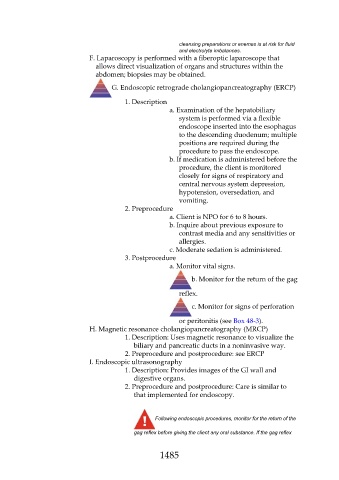Page 1485 - Saunders Comprehensive Review For NCLEX-RN
P. 1485
cleansing preparations or enemas is at risk for fluid
and electrolyte imbalances.
F. Laparoscopy is performed with a fiberoptic laparoscope that
allows direct visualization of organs and structures within the
abdomen; biopsies may be obtained.
G. Endoscopic retrograde cholangiopancreatography (ERCP)
1. Description
a. Examination of the hepatobiliary
system is performed via a flexible
endoscope inserted into the esophagus
to the descending duodenum; multiple
positions are required during the
procedure to pass the endoscope.
b. If medication is administered before the
procedure, the client is monitored
closely for signs of respiratory and
central nervous system depression,
hypotension, oversedation, and
vomiting.
2. Preprocedure
a. Client is NPO for 6 to 8 hours.
b. Inquire about previous exposure to
contrast media and any sensitivities or
allergies.
c. Moderate sedation is administered.
3. Postprocedure
a. Monitor vital signs.
b. Monitor for the return of the gag
reflex.
c. Monitor for signs of perforation
or peritonitis (see Box 48-3).
H. Magnetic resonance cholangiopancreatography (MRCP)
1. Description: Uses magnetic resonance to visualize the
biliary and pancreatic ducts in a noninvasive way.
2. Preprocedure and postprocedure: see ERCP
I. Endoscopic ultrasonography
1. Description: Provides images of the GI wall and
digestive organs.
2. Preprocedure and postprocedure: Care is similar to
that implemented for endoscopy.
Following endoscopic procedures, monitor for the return of the
gag reflex before giving the client any oral substance. If the gag reflex
1485

